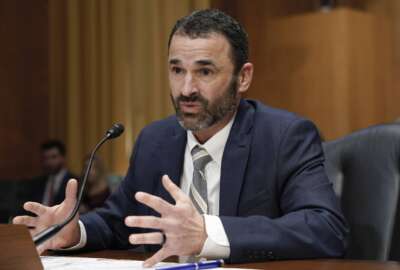Hubbard Radio Washington DC, LLC. All rights reserved. This website is not intended for users located within the European Economic Area.
On Air: Federal News Network
Trending:
Redundant agency programs wasting billions of dollars
From catfish inspections to military uniforms, redundancy problems within government agencies span virtually every major department and agency across government...
Federal agencies are duplicating one another’s efforts and missing opportunities to save money in programs ranging from overlapping efforts to ensure the safety of catfish in the U.S. food supply to poorly-planned rollouts of cloud computing, the Government Accountablity Office found in its latest annual review of government inefficiencies.
The report, released Tuesday afternoon, outlines 17 government mission areas in which agency programs duplicate one another, overlap with each other or are fragmented across agencies in an uncoordinated fashion. For the 2013 report, GAO found 14 additional areas in which the problem isn’t redundancy, but rather that agencies are missing opportunities to reap cost savings or bring in additional revenue. 
Gene Dodaro, the U.S Comptroller General told the House Oversight and Government Affairs Committee Tuesday that the problems span virtually every major department and agency across government.
“Part of the issue here is that when we identify these activities, they cross multiple departments. The Office of Management and Budget is the only organization that’s in a position to be a catalyst that can look across the entire executive branch,” he said. “In my opinion, a fundamental flaw of our current executive branch organization is that there’s really no accountability when multiple agencies are involved in a process, and more and more issues are requiring agencies to be involved because of the complexity of the problems the country faces.”
Werfel: Changes could save more than $25 billion in 2014
The report’s release came a day before the scheduled release of the Obama Administration’s 2014 budget proposal. In a White House blog post Tuesday, Danny Werfel, the Office of Management and Budget’s controller, pointed to the White House’s previous efforts to reduce unnecessary spending under the campaign to cut waste, and said the budget President Obama will propose Wednesday will include 215 proposals to cut and consolidate federal programs. He predicted the changes, if enacted, would save more than $25 billion in 2014.
Pointing to the duplication GAO has discovered over the past year, auditors highlighted the Agriculture Department’s pending implementation of a catfish inspection program within USDA’s Food Safety and Inspection Service, a step Congress mandated in the 2008 farm bill. GAO opined that the National Oceanic and Atmospheric Administration and the Food and Drug Administration already have the catfish safety problem well in hand with inspection programs of their own. Congress could save $14 million annually by canceling the redundant USDA program, GAO found.
Other areas of duplication in the 2013 report could be rectified within the executive branch without congressional action.
For example, this year’s report pointed out that 31 federal agencies and departments are involved in buying geospatial data and the systems that house it, which often results in the government paying for the same data multiple times.
“The federal government spends billions of dollars every year to buy this information, and it’s been well documented that there are duplicative investments,” Dodaro said. “We’ve focused on recommendations to ensure that there’s more effective coordination by a joint committee that’s focused on this issue. In this case, they’ve got a plan, but it’s not being executed. It’s got to be a priority.”
In another example, auditors also found significant overlap in research and development activities just within the Department of Homeland Security, mostly out of view of leaders at DHS headquarters. GAO explored 50 R&D contracts awarded by six components, and found that 29 of them overlapped with other R&D activities in DHS. Altogether, the department spent $66 million on those awards.
Concerns over coordination between DoD, VA raised
Overseers also found fault in the Defense Department’s uncoordinated approach to developing and acquiring ground combat uniforms. In 2002, most U.S. military combat uniforms in each branch of the armed services were made from one of two patterns: a woodland variant and a desert variant. Since then, the services have gone separate ways and each developed their own camouflage patterns, for a total of seven patterns today. GAO found DoD could save $82 million by better coordinating the development and purchasing of uniforms between the military departments.
GAO also has major concerns about coordination between the departments of Defense and Veterans Affairs, and in particular, the effort to create an interoperable health record that serves both military members and veterans. The departments stepped back from their plan to unite around a single record system earlier this year, and instead, start from separate systems and try to make them interoperable over time.
But Joel Willemssen, GAO’s managing director for information technology, said it’s troubling that the departments haven’t yet been able to describe their Plan B with much detail.
“We’ve expressed concern about the lack of a plan to carry this out. DoD and VA have said they thought they could do this in a more cost-effective way by continuing with two separate systems, but when pressed on that, they said the analysis is not yet complete,” he said. “We’ll have to wait and see whether the analysis bears that out or not.”
Dodaro said that analysis ought to include the idea of one department simply adopting the other’s existing health record system. 
Apart from addressing duplication and overlap, this year’s edition of the report made several recommendations for ways that agencies could reduce costs or increase inflows into the treasury.
For example, if the IRS were to shift about $120 million of its limited tax audit resources from examining low-income returns to looking at high-income ones, it could recover an additional $1 billion in underpaid taxes per year, GAO estimated.
Likewise, Dodaro said the IRS could narrow the gap between taxes owed and taxes paid — a figure that stood at $450 billion as of 2006, the latest year for which figures are available — by making more use of third-party data to determine the actual income of businesses and individuals.
“The data matching aspect of this is the most effective and efficient way to handle this problem,” he said.
In the information technology arena, GAO found that across government, agencies have failed to reap the promised cost savings of migrating to cloud computing because their plans did not always include performance goals, plans for retiring legacy IT systems or specific migration milestones.
In a related item, auditors estimated that five agencies it reviewed are spending 69 percent of their overall IT budgets on the “steady state” operation and maintenance of legacy systems. Stronger leadership oversight could allow agencies to cancel systems that no longer meet mission needs, or overlap with other IT investments, GAO said.
To coincide with the release of the third annual report, GAO also rolled out a new website to track agencies’ progress in implementing the recommendations to reduce duplication and inefficiency it has made over the past three years.
Of the 300 action items the office detailed in its 2011 and >2012 report, agencies have fully addressed 65 and partially addressed 149. Eighty-five have not been addressed at all, GAO said.
RELATED STORIES:
GAO: ‘Virtually all’ agencies may have overlapping programs
Congress to take on billions in duplicative programs
7 agencies make progress on implementing ‘cloud first,’ GAO says
Copyright © 2024 Federal News Network. All rights reserved. This website is not intended for users located within the European Economic Area.
Jared Serbu
Jared Serbu is deputy editor of Federal News Network and reports on the Defense Department’s contracting, legislative, workforce and IT issues.
Follow @jserbuWFED
IRS seeks $104B for multi-year modernization fund to maintain customer service improvements
Related Topics





